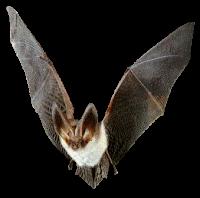The bats, sometimes known as flying foxes, are creatures of the night, much like owls and other nocturnal animals. These winged creatures primarily feed on fruits, nectars of flowers, and insects. The order in the animal kingdom called Chiroptera plays an important role in the ecosystem and the regulation of insects on the planet, as they prevent most parasitic species from overpopulating. It is astounding to note that a single bat can eat nearly one thousand insects in an hour.

The most popular out of all those false assumptions is arguably the one where almost everybody says that bats are blind. This belief has even contributed to the saying “blind as a bat” that has been used in many different languages besides English. This phrase is used to denote a person with such poor eyesight that he or she can be considered blind.
Contrary to popular belief, bats are really not blind. There are more than one thousand species of bats, and almost all of them have fairly good vision, although their hearing often outclasses their sight. Bats are naturally sensitive to the variations in levels of light, and they use these levels to determine the time to get active for hunting. When the light level gets low, they would usually use their ears more than their eyes, as they cannot see everything in the dark, but they can indeed hear everything.
Two Types of Bats
Bats are primarily divided into two categories: the first is the Megabats (Megachiroptera), and the second is the Microbats (Microchiroptera). The former, which are significantly lower in number in terms of species and population, are the larger ones in the order and have relatively large eyes. They use their eyesight for hunting and navigating without hurdles, even if it is during the day or night. The microbats, however, which constitute for around 70% of all bat population, have small eyes and rely on a hearing technique called echolocation for hunting and flight as well.
Echolocation is also referred to as second sight and sonar sight for bats, as echolocation is like a biological radar system for them. Bats are innately capable of producing high-frequency waves, and they emit these signals and listen to the sound waves that are bounced off on any object that catches the waves, whether it is prey or an obstacle in the bats’ path. The auditory information that is sent back to their ears is then converted into a visual map in their brain, thus helping them see in the dark. However, the visual map can only be completed if the bat is able to send signals consistently in one area, so they cannot visualize the environment if they only use one sound wave.
Bat’s Echolocation
The aspect of echolocation that is subject to debate is whether or not they got this feature after evolving to have the ability to fly. Researchers believe that bats are related to primates who have gained the ability to fly in order to capture prey more efficiently. But many argue that bats and apes are vastly different in terms of body structure and behavior. Despite the effectiveness of echolocation, even micro bats would sometimes use their vision to detect objects that are outside the range of their emitted sound waves. It is crucial to note that the ability only works within ten to twenty meters. This limitation may have been the reason why they are usually seen in caves and forests, as these locations have less dead spaces, unlike deserts and plains that have vast and open areas, thus allowing their sound waves to bounce to a lot of objects.
Unfortunately for bats, there are some animals that have evolved to counter their echolocation ability. One of these animals is the tiger moth that produces aposematic ultrasound, which signals bats that they are not worth eating since they don’t taste good, and they are protected with poisonous chemicals. In addition, these tiger moths are also capable of creating signals that jam the echolocation of bats, and this helps the insects to remain undetected at night. Tiger bats, along with other moth species, have a special organ in their bodies called the tympanum that can detect bat sound waves from several meters away. After detecting a signal, the tympanum will cause the moth’s body to twitch, prompting it to move to another location where the special organ will not cause twitching anymore.
Bat’s Eyesight
In terms of bats’ eyesight, they don’t have a good ability to distinguish colors since they only have a mesopic vision, compared to most mammals that have a photopic vision. However, bats have much better sight than humans in specific conditions wherein there are low levels of light. Some species of bats have even evolved to detect ultraviolet (UV) rays, which helps them determine whether it is sunny outside or not. Besides these great abilities related to their eyesight, bats are also sensitive to the magnetic field of the Earth, and this ability helps them determine whether they are flying north or south.
The probable explanation as to why the belief that bats are blind has emerged must be because of their pattern of flight at night. Bats typically move rapidly in the dark, and they may occasionally just graze against us, which prompted many people to believe they don’t know where they are going. But the grazing may have only been caused by how quickly they fly, as they don’t have many means to change their direction while flying.
